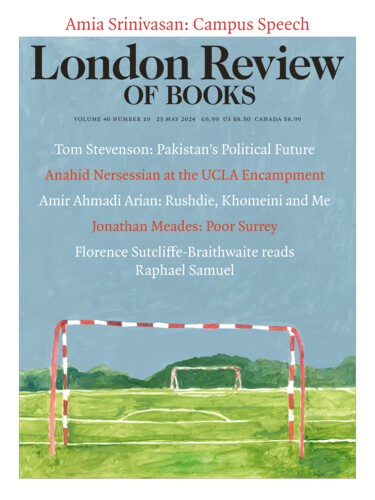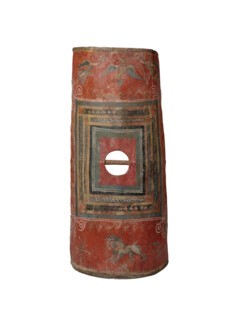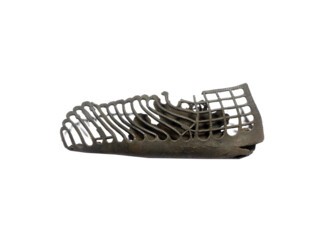Among the swords, daggers, scabbards, spearheads, shields, helmets, belts, cuirasses, trumpets, tombstones and portrait busts of emperors that you might expect to find in an exhibition entitled Legion: Life in the Roman Army (at the British Museum until 23 June) are a number of less martial, more everyday objects: louse combs, drinking vessels, tent pegs, manicure sets, games and, perhaps most arresting of all, a single red woollen sock, from about the third century AD. Most of the weapons and armour are in various states of decay, rusty and incomplete, but the sock looks as if it could have been knitted yesterday (despite the hole in the toe), both the wool and the red dye beautifully preserved in the sands of Egypt for hundreds of years. It was made to be worn with a sandal, as there’s a split where the thong goes between the big toe and the others, like Japanese tabi. It’s 24 cm long – about a UK size 6 – though the material stretches and it would probably have fitted the slightly larger foot that wore the leather and iron hobnailed sandal, or what remains of it, on display nearby, or the hobnailed boot from Vindolanda on Hadrian’s Wall. There’s a certain pathos to the solitary sock: it’s easy to imagine it being overlooked in the hubbub of striking camp and left behind when the legion marched on. But it turns out that’s just my ignorant fantasy, since there’s a pair of almost identical socks on display at the V&A, where the curators go into a lot more detail about the circumstances of their discovery: ‘Excavated in the burial grounds of ancient Oxyrhynchus … It is unclear whether the socks formed offerings to the dead or were used as foot coverings.’
Still, even if no Roman legionary ever wore this particular sock, they certainly wore socks, as we know from the letters of Claudius Terentianus, whose military career gives a narrative shape to the exhibition. Terentianus was a Roman citizen born in Egypt towards the end of the first century AD, whose letters home to his family, in both Greek and Latin, were among the papyri excavated at Kom Oshim in the 1920s. They are now part of the University of Michigan’s papyrology collection, though kept in Cairo. Terentianus joined up in 110 or 111 as an auxiliary in the marines based at Alexandria after his application to become a legionary was refused – because of bad references, he claimed. The legiones were open only (with rare exceptions) to citizens; non-citizens had to join the less well paid, less prestigious auxilia, and were rewarded on retirement after 25 years’ service (assuming they survived that long; half of them didn’t) with Roman citizenship, which their sons would inherit. In the book accompanying the exhibition, Richard Abdy, one of the curators, quotes Yann Le Bohec’s characterisation of the army as a ‘machine for creating Roman citizens’, at least until the Emperor Caracalla’s edict of 212 which extended citizenship to all free subjects of the empire.
Terentianus was able to transfer to a legion after a few unhappy years as an auxiliary. The exhibition includes recordings of an actor reading extracts from his letters: ‘I ask and beg you, father, for I have no one dear to me except you, after the gods, to send to me a battle sword, a pickaxe, a grappling iron, two of the best spears obtainable, a cloak of beaver skin and a girdled tunic, together with my trousers.’ In another letter he asks for a pair of felt socks (udones). The only item of uniform, as such, that a Roman soldier had was his belt, made of leather with ‘decorative metal plates … possibly related to rank’, with scabbards hanging from it for his dagger and sword. He had to buy and maintain his own armour. ‘For all its costume inaccuracies,’ Abdy writes, ‘the epic film Gladiator (2000) at least recognises the highly variable appearance of Roman soldiers.’
A row of helmets shows the way their design developed over a hundred years or more. As Abdy puts it, ‘the Roman helmet, generally speaking, had the appearance of a metal baseball cap worn backwards,’ and the peak got bigger over time, the better to protect the back of the wearer’s neck. The earliest of them, a bronze helmet from the first century AD with a short, straight brim, found in London, has been ‘tagged by four owners, suggesting up to a hundred years of use’, though that must be an optimistic estimate. The latest, from the late second or third century, found on the west bank of the Rhine, has ‘the full range of protective features’, with a ‘deep neck guard and reinforcing strips’, and looks as if it could have been worn by Oliver Cromwell, if it were iron instead of bronze. (There were a couple of replicas that visitors could try on, but one of them was too small for me and the other was being hogged by a man taking selfies; the nearby note about the prevalence of head lice in the Roman army was a little off-putting too.) Even more elaborate helmets, with face masks depicting Trojans or Amazons, were worn for parades.
There is, amazingly, only one surviving intact example of a scutum, the curved rectangular shield, like a segment of a cylinder, that’s familiar from Asterix books, the opening scenes of Gladiator and countless other swords-and-sandals epics. On loan from Yale, it was found in Syria on the west bank of the Euphrates, and dates from the third century. It has curled up a bit over time, and there’s a hole in the middle where its metal boss would once have been, but the red paint is still vibrant, and the paintings of an eagle and a lion – regimental symbols, perhaps – still vivid. Next to it in the display case is a bronze boss that has lost its scutum, dating from the first or second century and recovered from the River Tyne. A complete shield would have weighed up to 10 kg, and there’s a wooden replica that visitors are invited to lift: I wouldn’t want to march twenty miles carrying it.
An extraordinary suit of armour made of crocodile skin – found in Egypt and dating from the third or fourth century AD – is as mysterious as it is striking. It could have been an ‘underlayer to cushion a metal cuirass’ or a ‘religious costume’; and the headpiece, made from the crocodile’s scalp, ‘could be either for protective or ceremonial use’ or ‘a local adaptation of the tradition of Roman standard-bearers and trumpeters wearing skins of fierce animals over their helmets’. Trumpeters’ instruments are represented in the exhibition by a bronze cornu, or ‘horn of command’, curled like a bass clef and more than a metre in diameter, recovered from Pompeii, which would have been used to transmit orders ‘over the din of hobnail footsteps and clanking armour’; and a tiny bronze model of a mouse, barely 5 cm tall, playing a tuba (not a modern tuba but a short, straight trumpet). It was left to the British Museum by Richard Payne Knight in the early 19th century, but they don’t know where he picked it up.
Terentianus was asking his father to send all that stuff because he was about to set sail from Alexandria to Syria. Most of the artefacts in the exhibition come from the empire’s frontier provinces, where the army would have had its heaviest presence: Germany, Syria, Britain. In Book One of the Aeneid, Jupiter explains to Venus, Aeneas’ mother, that he has placed no limits on the Romans, either spatial or temporal, but given them sovereignty without end: ‘His ego nec metas rerum nec tempora pono;/imperium sine fine dedi.’ It isn’t clear that the poem necessarily endorses this view. Jupiter is speaking to reassure Venus after Aeneas and his storm-tossed band of Trojans, the last remnants of a once mighty civilisation, have been beached on the North African sands, obliged to throw themselves on the Carthaginians’ mercy. History and legend may be more reliable prognosticators than the promises of a fictional god. Troy fell; Carthage fell; why should Rome be any different?
The Roman Empire reached its greatest extent under Trajan, nearly 150 years after Virgil’s death, in the early years of Terentianus’ service. But even then it was bounded by the Rhine and Danube to the north, the Sahara to the south and the Syrian desert to the east. Soldiers were recruited from across the empire to enforce those frontiers, often a very long way from home: among the exhibits is the tombstone of a Syrian archer posted to Hadrian’s Wall. (The caption refers cheerfully to a ‘multicultural and multiethnic’ fighting force that used ‘locally sourced’ equipment.) Visitors are encouraged to spare a thought, it’s true, for those on the sharp end of the ‘multicultural’ army’s ruthless aggression: there’s a reconstruction of Arrian’s victory over the Alani in 135 AD and a sombre acknowledgment of the hideous aftermath of the battle.
Occupation could be as brutal as conquest. Terentianus was wounded while putting down a revolt in Alexandria: ‘We are suppressing the uproar and anarchy of the city. We have found the transgressors of the laws.’ Although, as a wall text notes, ‘most sources are Roman and present their perspective,’ it’s still possible to hear through the voice of the occupier and begin to imagine the conditions of the occupied. (Tacitus put his famous remark about the Roman army’s scorched earth tactics, ‘ubi solitudinem faciunt, pacem appellant,’ into the mouth of a Caledonian leader, Calgacus: ‘they create a wasteland and call it peace.’) ‘With limited numbers of soldiers policing a vast empire,’ another caption says, ‘military justice could be summary. Beatings were arbitrary, and criminals and rebels alike were routinely executed to discourage others.’ The skeleton of a victim of crucifixion is on display. A papyrus from 166 AD records a ‘sale contract between two marines for a seven-year-old Mesopotamian boy, Abbas’. In one of his letters to his father, Terentianus writes: ‘another basket was given to me by the soldier, in which I found two large loaves of bread and dates, and from the father of Iulius a small basket (sphyridallion) and my small baskets (talaria) and a sword-sheath. He sent me word about a woman; with my consent he was buying one for me.’
Most of the other visitors on the morning I was there were either retired or teenagers on school trips. In front of an exhibit detailing the engineering and building works that Roman troops carried out, I overheard one half of an elderly couple say to their companion: ‘I know our soldiers do things like that but it’s mostly bridges.’ Their voices were drowned out by what sounded like a heavy suitcase being wheeled over cobbles, but turned out to be something called the ‘wheel of misfortune’, a large wooden ratcheted wheel hanging on the wall, divided into twelve sectors, with a different fate written in each one, which you could spin to tell your fortune as if you were a Roman soldier: ‘You lost all your money gambling, no treats for you’; ‘Caught sleeping on guard duty. Punishment: execution!’; ‘Your feet are the smelliest in camp. Punishment: sock-washing duty.’ The secondary school students were enjoying it more than you might expect.
The exhibition doesn’t deny the downsides – including the high risk of death, from disease as well as battle – and at least gestures to the moral harm that comes of being obliged to maim and kill other people, but overall it presents a positive view of ‘life in the Roman army’. I couldn’t help wondering, as I watched the teenagers fooling around with the wheel of misfortune, whether the show wasn’t, however unintentionally, part of a subliminal recruitment drive (‘You belong here,’ as the latest British army enlistment ads would have it). The interactive exhibits have their ancient Roman equivalents in the wooden toy swords on display that Roman children once played with, in part to prepare them for joining the army themselves. In January, a week before Legion opened, the head of the British army, General Patrick Sanders, made a widely reported speech at an armoured vehicles conference: ‘As the prewar generation we must … prepare,’ he said, ‘and that is a whole-of-nation undertaking … regular armies start wars; citizen armies win them.’ On a trip to Warsaw in April, Rishi Sunak said that the UK’s defence industry is to be put ‘on a war footing’.
You come out of the exhibition, leaving Terentianus to his comfortable retirement and a bucolic recording of chirruping cicadas, into the Egyptian galleries of the British Museum’s permanent collection, filled with artefacts acquired thanks to the efforts of other imperial armies, hundreds of years after the Roman occupation of North Africa. The red sock was picked up in Egypt by William Joseph Myers, a British army officer who also fought at the outer limits of the British Empire in Sudan, India and South Africa. He was killed at the age of 41 in 1899, during the Second Anglo-Boer War, leaving his loot of more than 1300 works of ancient Egyptian art to his old school, Eton, though his executors distributed the old socks among London’s museums. Imperium sine fine.
Send Letters To:
The Editor
London Review of Books,
28 Little Russell Street
London, WC1A 2HN
letters@lrb.co.uk
Please include name, address, and a telephone number.





